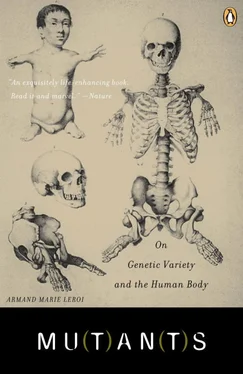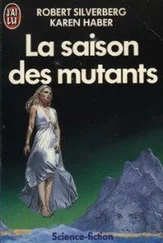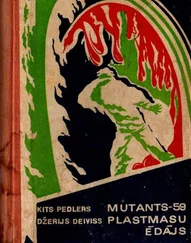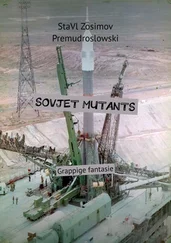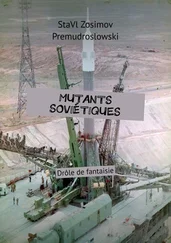Fibrodysplasia ossificans progressiva. Harry Eastlack (1930–73). (1990 © Scott Lindgren, courtesy Blast Books, New York)
Pseudoachondroplasia. Elizabeth Ovitz (1914–92) and siblings. Bat Galim, Israel c.1949. (Yehuda Koren and Eliat Negev, Jerusalem)
Achondroplasia. Mary Ashberry (d.1856) with skull of stillborn infant. (Linda Lindgren, Los Angeles, and Gretchen Worden, Mütter Museum, Philadelphia)
Osteogenesis imperfecta type II. Stillborn infant, Amsterdam. (Jan-Roelof Oostra, Vrolik Museum, Amsterdam)
Pycnodysostosis (putative). Henri Toulouse-Lautrec (1864–1901). (Musée Toulouse-Lautrec, Albi, Tarn, France)
Pygmy depicted with achondroplasia. Attic red-figure rhyton c.480 BC. (Hermitage, St Petersburg)
Pituitary dwarfism. Joseph Boruwlaski (1739–1837). Unknown painter (Norodwe Museum, Crakow)
Pituitary gigantism. Charles Byrne (1761–1783). (Hunterian Museum. Reproduced by kind permission of The Royal College of Surgeons of England)
Skeletons of Aka pygmy woman, Caucasian male, gorilla. Pygmy skeleton collected by Emin Pasha, Congo 1883. (Wellcome Library, London)
Negritos. Port Blair, Andaman Islands, 1869–80. E.H. Mann. (Royal Anthropological Institute of Great Britain and Ireland)
Thibaut-Francesco and Chair-Allah-Luigi, Verona c.1874. From Armand de Quatrefages 1895 The pygmies . (Author’s collection)
Daru or Taron man. Upper Burma c.1937. From F. Kingdon Ward 1927 Plant hunter’s paradise. (J. Rasmussen and The Royal Geographical Society, London)
Myxdematous cretins aged about twenty, with normal man. Democratic Republic of Congo (Zaire) c.1968. (François Delange, ICCIDD Brussels)
Castrato. Senesino singing Handel’s Flavio , London c.1723. Attrib. William Hogarth. (Victoria and Albert Museum, London)
Proteus syndrome. James Merrick (1862–90). (The London Hospital)
Hermaphroditus asleep. After Nicholas Poussin 1693. (Wellcome Library, London)
Female internal genitalia. From Andreas Vesalius 1543 De humani corporis fabrica. (Wellcome Library, London)
Clitoris and vestibular bulbs. From Georg Ludwig Kobelt 1844 Die Männlichen und Weiblichen Wollusts-Organe des Menschen und Einiger Saugetiere. (Wellcome Library, London)
Male pseudohermaphroditism. Herculine Barbin (1838–68). From E. Goujon 1869 ‘Étude d’un cas d’hermaphrodisme bisexuel imparfait chez l’homme’. Journal de l’anatomie et de la physiologie normales et pathologiques de l’homme et des animaux 6:599–616 (British Library)
Oculocutaneous albinism type II. Zulu man, Natal. From Karl Pearson et al. 1913 A monograph on albinism in man. (Wellcome Library, London)
Linnaeus’ Homo trogylodytes or Bontius’s orang. From Karl Pearson et al. 1913 A monograph on albinism in man. (Wellcome Library, London)
Oculocutaneous albinism type II. Geneviève. From George Leclerc Buffon 1777 Histoire naturelle générale et particulière. (Wellcome Library, London)
Piebalding. Marie Sabina, Columbia 1749. From G.L. Buffon 1777 Histoire naturelle générale et particulière. (British Library)
Piebalding. Lisbey, Honduras 1912. From Karl Pearson et al. 1913 A monograph on albinism in man. (Wellcome Library, London)
Hypertrichosis lanuginosa. Arrigo Gonsalvus, Rome 1599. Detail from Agostino Carracci Arrigo Peloso, Pietro Matto e Amon Nano. (Capodimonte Museum, Naples. © 2003 Photo Scala, Florence)
Hypertrichosis lanuginosa. Petrus Gonsalvus, Austria c.1582. Unknown painter, German school. (Sammlungen Schloss Ambras/Kunsthistorische Museum, Vienna. Photograph © Erich Lessing/AKG, London)
Hypertrichosis lanuginosa. Maphoon, Burma c.1856. E.H. Mann. (Royal Anthropological Institute of Great Britain and Ireland)
Supernumerary breast on thigh. (Wellcome Library, London)
Artemis Ephesia in Sweden. Frontispiece of Linnaeus 1761 Fauna svecica. (Wellcome Library, London)
Luigi Cornaro (1464–1566). Tintoretto. (Galleria Palatine. © 1990 Photo Scala, Florence)
Skull of an Australian Aborigine, Arnhem Land. From Armand de Quatrefages 1882 Crania ethnica: les cranes des races humaines.
Variation in human skulls. From Armand de Quatrefages 1882 Crania ethnica: les cranes des races humaines.
Group of Selk’nam, Tierra del Fuego c.1914. (The Royal Geographical Society, London)
Armand Marie Leroi, in addition to many technical articles on evolutionary and developmental biology, has written for the London Review of Books and The Times Literary Supplement. He was appointed Reader in Evolutionary Developmental Biology at Imperial College in 2001 and was also warded the Scientist for the New Century medal by the Royal Institution of Great Britain. Mutants is his first book.
Visit Armand Marie Leroi on the web: http://armandleroi.com/index.html.
“Armand Leroi is not yet a household name but he soon will be, if Mutants wins the following it deserves. The discovery of a distinguished scientist who can write with such style and flair is cause for rejoicing.”
—
The Independent
“Leroi has an extraordinarily extensive familiarity with a dazzling range of information…. [He] draws tight his net of wonderful human diversity and gracefully displays its contents, and I am full of admiration … an exquisitely life-enhancing book. It captures what we know of the development of what makes us human…. Read it and marvel.”
—
Nature
“Leroi’s debut is a gloriously inquisitive and even hopeful journey into the making and unmaking of human beings, a recognition that genetic variation is essential to life even as it bears us down to our graves.”
—
The Village Voice
“Leroi is a gifted storyteller … he places each mutation in a literary framework.”
—
TimeOut New York
“In a series of erudite, gracefully crafted essays, Leroi guides us through a wealth of medical phenomena—both the normal and the shockingly abnormal… he lifts us up from an instinctive horror at the bizarre to a more profound sense of wonder.”
—
The Sunday Times (London)
“There are three things that lift this book above mere exploitation: the seriousness of Leroi’s scientific investigations; the humane concern he manifests for the suffering of others; and the sensitivity of his aesthetic appreciation of the wonders of nature…. [His] patient unfolding of the mysteries of modern genetics… Poetic, philosophical, profound, witty and challenging, Leroi is, as he says of Goya, a ‘compassionate connoisseur of deformity.”’
—
The Guardian (London)
“For those who truly wish to know their origins without consulting a dry academic tome, this is a book to read.”
—
The Economist
“Gracefully written and up-to-date account of the state of the field. His approach is cunning; like a fairground barker, he first appeals to our voyeurism, but then adroitly bends our interests toward the science underlying the mutants…. Mutants roams engagingly through great swathes of literature, mythology, and history…. Well worth reading, not only for its fascinating tales of development, but also for its scrutiny of a vast uncharted area of biology.”
—Professor Jerry A. Coyne, TLS
“Leroi writes about the body with Pateresque delicacy; he is an aesthete for whom understanding enhances mystery; an artist who gazes at the dance of genes as the fetus forms itself.”
—
Sunday Telegraph (London)
“In a book that’s as disturbing as it is enlightening, as unsettling as it is compelling, Leroi examines all sorts of genetic variability in humans and explains how that variability helps scientists understand the processes associated with human growth and development… . Although the subjects Leroi presents—conjoined twins, individuals with cyclopia (a single eye), deformed or missing limbs, abnormal height… often appear grotesque, he approaches all of his topics and each of his human subjects with great respect.”
Читать дальше
